Editor’s Note:We thank Dr. Yi Li for giving us the permission to translate this paper into English and publish both the Chinese and the English versions on www.ChinaUSFriendship.com; this paper is the full text of the morning speech on sociology given by Dr. Li on June 13, 2013, at Shandong University. This article and Dr. Li Yi's speech at Tsinghua University can also be found in Chinese on major websites including:
http://www.csstoday.net/xueshuzixun/jishizixun/80965.html;
http://finance.china.com.cn/roll/20130419/1400941.shtml;and http://www.csstoday.net/Item/68717.aspx
4. Social stratification of China 1979-1993
During this period of time, the structure of China’s social stratification underwent tremendous changes as shown in Figure 5-3. First, the non-agricultural labor force, which accounted for only a quarter of the total in 1979, rose to nearly half of the total in 1993. This was tremendous progress and a brilliant achievement in the structure of China’s social stratification. Second, migrant workers increased from more than 20 million to more than 100 million, outnumbering the urban workers, and became the main force of China's working class. Third, the Chinese national bourgeoisie was reborn.
The reason on the one hand was the wisdom, courage and boldness of Deng Xiaoping’s leadership in reform and opening up. On the other hand and equally important was the international situation which had undergone very significant changes. Due to the support of China and the Soviet Union for Vietnam, the United States got bogged down in the quagmire of the Vietnam War and its national strength significantly declined. In 1971, the People’s Republic of China returned to the United Nations (UN) and became a permanent member; in 1972, the U.S. President Richard Nixon visited China; in 1976, the United States retreated from Vietnam; in 1979, the Soviet Union invaded Afghanistan; China, the United States and Pakistan supported Afghanistan to fight back the Soviet Union; the Soviet war in Afghanistan was in such deep trouble that it was difficult for the Soviet Union to extricate itself. In 1985, Deng Xiaoping made the judgment that for a long time China would not face war. Then, he decided to change the guidelines of basic national policy away from constant combat-readiness designed to respond to large-scale alien invasion since 1840. In order to focus on economic construction, he stopped the Three-line Constructions and speeded up the development of industrialization, urbanization and modernization. In 1991 the Soviet Union collapsed, which made China more determined to concentrate on economic development and wholeheartedly firmed its strategic determination for development. Later, the first two decades of the twenty-first century was proposed to be the period of important strategic opportunities; but now this issue is somewhat controversial.
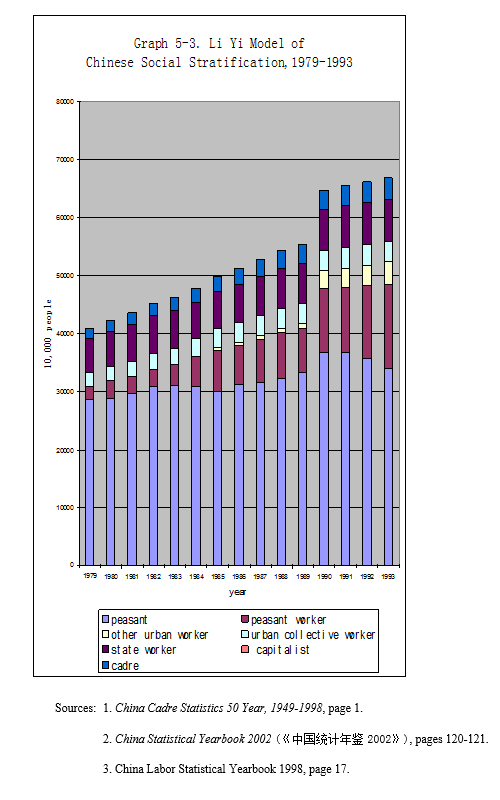
5. Social stratification of China 1993-2011
During this period, the structure of China’s social stratification underwent an even more dramatic change as shown in Figure 6-3. It made more brilliant achievements as well as had extremely serious problems. First of all, a brilliant achievement was the outstanding performance of the non-agricultural labor force which increased from about one half of the total labor force in 1993 to about four-fifths in 2011; in other words, the agricultural labor force was down from about one half to one fifth. This was a brilliant page in Chinese, Asian and world history.
Second, both the number and strength of the Chinese national bourgeoisie developed rapidly. This topic will be discussed specifically later. Third, in 1996, Asia had a financial crisis. The Chinese state-owned enterprises for the first time encountered an overall loss since the founding of the country. The Central Government decided to help the big enterprises and let the small enterprises go out of business. In a few years’ time, the number of workers of Chinese state-owned enterprises dropped from more than 80 million down to merely more than 20 million. This matter is over now. But some consequences are still reflected in literary and artistic works, such as the movie "A Piano Made of Iron and Steel". Also, a few days ago, a laid-off worker who was dissatisfied with the society died together with all the passengers of a bus. This was just an occasional event. Fourth, in addition to the 40 million cadres, because of the explosive development of higher education, the number of quasi-cadres (prospective cadres) underwent substantial growth and reached 80 million in 2011.
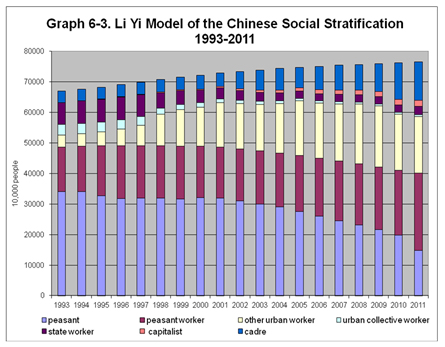
Fifth, the most serious problem is the current hukou system that has caused urban and rural isolation. It is the cancer of the Chinese social and economic development and has all along not been removed. Given that that the non-agricultural labor force in China has reached four-fifths of the total labor force, however, the percentage of China's urbanization, if we do not lie, is only 35 percent. This issue will be specifically discussed later. Sixth, the rich-poor wealth gap and the growing income disparity continue to develop. Seventh, as Mr. Sun Liping (孙立平) and others suggested and emphasized, from the late nineties the structure of China’s social stratification has stayed rigid, social mobility has become more and more difficult. For example, the college entrance examination becomes increasingly unfair. If the people who have money, power or influence take away most resources, then the people who do not have money, power or influence will have difficulty with upward mobility and certainly cannot survive long. How can our birth prevent us from becoming princes and barons, generals and ministers?
6. Social stratification of China 1952-2011
A panoramic picture of the structure of New China’s social stratification over sixty-some years is shown in Figure 8-1. Figure 8-1 is the combined result of Figures 3-3, 4-3, 5-3 and 6-3. In 2011, the general structure of China’s social stratification was: 40 million cadres, 80 million quasi-cadres and 20 million bourgeois constituted the upper class; below the upper class, there were 470 million workers which included three classes: 250 million migrant workers, 26 million workers in state-owned enterprises, 6 million workers in collectively-owned enterprises and 186 million urban workers of other kinds; further down below these classes were the 150 million farmers. Some of the data need to be corrected. But the errors will not be great as to change the basic structure. Let us briefly look at the various classes and strata.
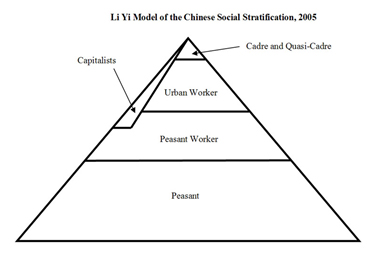
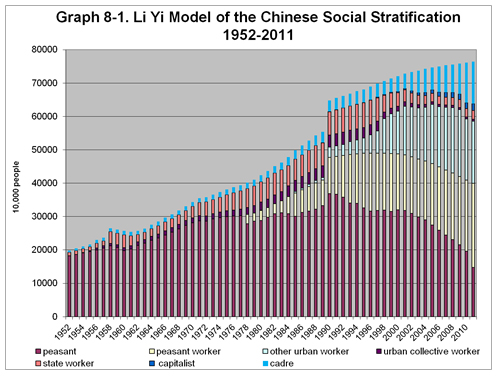
7. Cadres and quasi-cadres
There are two detailed and accurate sources concerning China's 40 million cadres: 1) data from the Organization Department of the Communist Party of China (CPC) Central Committee: China Cadre Statistics 50 years, 1949-1998 (《中国干部统计50年1949-1998》), Party-founded Reading-material Press, 1999; and 2) “Review the Work of the Leadership Groups and the Ranks of Cadres after New China’s Establishment over 60 Years” by Tan Hao (谭浩)and Zhao Chao (赵超),
http://news.xinhuanet.com/politics/2009-09/27/content_12116542.htm.
From 1998, the total number of cadres of China has remained at 40 million. By the end of 2007, the number included 6.89 million cadres working in the government offices, 23.13 million working in state-owned institutions and 9.42 million working in the state-owned enterprises. Chinese people are familiar with the fact that the cadre ranks can be divided into the provincial army level, the prefectural division level, the county regiment level, the township section or battalion level, the sub-section or company level, and the general cadres. In theory, the 40 million cadres can be categorized into similar levels, including all levels of the state-religious workers.
Prior to 1993, the university graduates and the majority of college or above degree graduates automatically became national cadres. Since 1993, with the explosive growth of higher education, fewer and fewer university graduates automatically become national cadres and most of them have to find jobs. But the state has treated them with privileges. In all of China, the majority of workers look for jobs in the labor market. And college graduates look for jobs at all levels in the nationwide job markets, and enjoy some of the benefits that labor markets do not provide to the workers. Therefore, I call these people who are college graduates, but do not become national cadres or work in the non-public sectors or take informal work in the state sector, "quasi-cadres". The national personnel departments at various levels manage the quasi-cadres the same ways as they manage the cadres, such as keeping their personal files and evaluating their job titles. I find that in recent years, the mainland scholars have begun to use the concept of quasi-cadres. In 2011, mainland China already had more than 80 million quasi-cadres.
Next I am going to discuss the fact that the future Chinese middle class will mainly come from the development and growth of the quasi-class. The employment difficulty of college graduates lies not in having too many of them but in China's current social and economic development model which is not the independent innovation model; instead it is the processing industry model which depends on foreign research and development. If this problem is not solved, it is difficult for China to avoid the "moderate-development trap", or the "middle-income trap", to give birth to the middle class.
My unworthy writing (translator’s note: a humble expression) has made a comprehensive and detailed analysis of Chinese cadres. The great achievements of New China over the last sixty-some years and the great success of reform and opening up over the past three decades are the contributions of leading cadres at different levels and of all cadres. For more than 60 years, the cadres’ income, prestige and socioeconomic status, on the whole, have always been higher than for the working class and the peasantry. Only in the recent one or two decades have the income and prestige of some bourgeois surpassed those of the cadres.
At present, the Chinese society has a serious problem and that is, China has not implemented the public official property declaration system (translator’s note: a project requiring all Party and government officials to report their assets to the public). Next, I shall talk about the issue that in the recent one or two decades, the rapid development of trading power for money has combined some members of the cadres and some bourgeois into one group.
8. Chinese bourgeoisie
American and Chinese academic circles have made great achievement in research on the Chinese bourgeoisie. As long as there is a market economy, it will produce a bourgeoisie. The achievement made by the thirty years of China's reform and opening up is largely the achievement of China's market economy, and also the achievement of the Chinese bourgeoisie. In China's GDP, how large is the contribution of the Chinese bourgeoisie? Or how much does the non-public sector account for? Most U.S. and Chinese researchers believe that it is three quarters to four fifths. I think that it is more than four fifths. In recent years, I have interviewed more than a dozen private entrepreneurs in the Pearl River Delta (PRD).
The bourgeoisie in the U.S., Japan and Europe, especially the bourgeoisie in the U.S., shows significant differences from the bourgeoisie in China. The U.S. has high-speed computers, an equipment manufacturing industry, fighter jets, nuclear submarines, intercontinental missiles, aircraft carriers and tanks. The majority of the most advanced technologies of the U.S. are the research, development and production results of the American capitalists. These technologies are sold to the U.S. government and the U.S. military for their use. In my book, there is a paragraph on the nature of the bourgeoisie of today's China, which reads as follows:
I think that in the foreseeable future, the bourgeoisie of China will continue to be a part of the upper class, instead of becoming a part of the national leadership group, especially at the central government and the provincial level. The bourgeoisie of China will have to be subordinate to its country. This is not only determined by China's politics and economy, but also by China's position in the world system. Simply put, in the next few decades, the impact of U.S. policy on the position and role of China’s bourgeoisie in Chinese society will be much larger than any other factors. In the foreseeable future, China's non-public economy will continue to focus on the low-tech and labor-intensive industries. This is determined by the essence of today's world system and the U.S. technology hegemony. At present, China's non-public economy is mainly producing low-tech and labor-intensive products that the U.S. companies stopped to manufacture several decades ago. China’s state-owned economy is engaged in the production of high-tech and capital-intensive products. These products are indispensable to China as a modern nation-state, and the United States will never sell them to China, especially in the area of weapons of mass destruction, such as fighter aircraft, aircraft carriers, nuclear submarines, advanced radar, advanced communications equipment, and more importantly, the manufacturing industry that can produce machines to be used to make these products and the manufacturing industry that makes advanced materials. Only the public sector has the ability to research, develop and manufacture these products. This is why the public sector still employs the majority of educated elite despite the non-public economic output being 3/4 to 4/5 of China’s GDP. As long as the U.S. does not sell these high-tech products to China and forbids other countries selling them to China, China must maintain a robust public economy. The bourgeoisie of China is essentially powerless in these fields (The Structure and Evolution of Chinese Social Stratification, pages 191-192).
For over twenty years, the relationship between the Chinese bourgeoisie and the Chinese government, in general, has been good. There were individual cases that had problems, but the government never confiscated their properties, instead, it took a buy-out approach. For example, the private coal industry in Shanxi (山西) had some socio-economic problems, so the Central Government spent three hundred billion yuan to engage in an industry-wide buy-out. Another example is that the private steel industry had some social problems and emergencies (the Tong Gang Incident通钢事件), so the government also funded its buy-out.

China's officially published figure of the bourgeoisie is shown in Figure 8-3. This figure includes mainland urban capitalists and peasant capitalists who hire more than 8 employees. My book (page 188) makes a special analysis of this topic and suggests that this figure was considerably underestimated. Some people, amid the rapid socio-economic development, happened to naturally become a part of the Chinese bourgeoisie; for example, some of the farmers whose lands were acquired at astronomical prices and became rich overnight. The Chinese mainland bourgeoisie includes at least the following two other types. First, in the recent one or two decades, some cadres received a portion of money and assets; since the amount was much higher than their wage incomes, they became part of the Chinese bourgeoisie. Second, some cadres, publically or privately, became shareholders of some enterprises; the dividends they received greatly exceeded their wage incomes. When I was in the elementary and junior high schools, the loudspeaker broadcasted a Mao quotation: "The bourgeoisie is inside the Communist Party". In the 80s, we thought, Mao Zedong must be getting old and confused to give this incoherent speech. It now appears to be so realistic.
Money-power exchange and money-power combination have made some of the party members and cadres a part of the Chinese into members of the bourgeoisie. What can be done? The American, Japanese and European academia circles have not discussed this matter. In the Chinese academic circle, some scholars have suggested to take the decriminalization approach or the amnesty approach to solve this problem. I think that the stripping method can solve this problem. In short, the wealthy officials and party members can quit the political party and resign to become cadres and join the association of industry and commerce. Their representatives can become part of the business representatives; the National People’s Congress (NPC, 人大) and the Chinese People's Political Consultative Conference (CPPCC, 政协) at all levels can also make arrangements for them. Then, a strict system of separating money from power, isolating money from power, can be implemented; see my book Introduction to Sociology (2011), Chapter IX, "Political Sociology", Section II, "The Chinese Road of Democratization," and Sub-section II, "Party Officials’ Property Declaration and Inheritance Limit" (pages 150-151).
9. The Chinese working class
The rapid development and expansion of the Chinese working class, rather than the formation of the Chinese middle class, is the main theme of the evolution of the structure of China’s social stratification. In 2011, the Chinese working class grew to 470 million, actually 470,870,000, as shown in Figure 8-2. This included 26.54 million state workers, 6.03 million workers in collectively-owned enterprises, 185.52 million urban workers in non-state-owned enterprises and 252.78 million migrant workers.
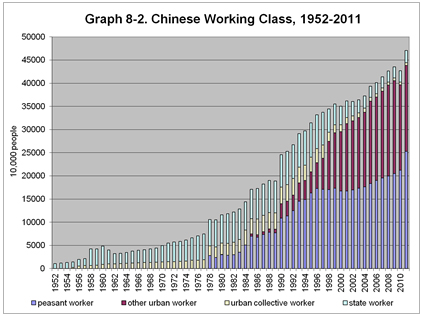
The present Chinese ruling party and the Chinese government do not deny the existence of class in today's Chinese society, do not deny the existence of a leading class in today's Chinese society, do not deny the existence of a class basis in today's Chinese Communist Party, and do not deny that some social classes are the main force in today's Chinese society. Chairman of the Central Military Commission Xi Jinping pointed on April 28, 2013, that "the working class is the leading class of our country, is the representative of China's advanced productive forces and production relations, is our Party’s most solid and most reliable class basis, is the main force for building a moderately prosperous society, is the main force for upholding and adhering to the development of socialism with Chinese characteristics. In order to uphold and adhere to the development of socialism with Chinese characteristics, we must wholeheartedly rely on the working class, consolidate the leadership-class status of the working class and fully develop the working class as the main force". Each year for more than 10 years, before and after the May 1 Labor Day Holiday, Jiang Zemin (江泽民) and Hu Jintao (胡锦涛) made similar statements. In the Chinese academic circle, some scholars have argued that the present ruling party and the government in China do not think that class exists in todays’ China and have been unwilling to see the word “class”. There is obviously a discrepancy to this fact.
Before the reform and opening up, the state workers in a sense were a labor aristocracy above the majority of farmers and only under a small number of cadres. Some of the state workers' incomes and prestige were also higher than some of the low-level cadres. Since 1988, within a few short years, the more than 80 million state workers shrank to little more than 20 million. Many of them experienced the process of being laid off. Those who were laid off are now retired. Now there are more than 26 million state workers and more than 3 million workers in collectively-owned enterprises. In accordance with Premier Zhu Rongji’s (朱镕基)saying: the state-owned enterprises are concentrated in banking, investment, insurance, power generation, power transmission, tobacco, petroleum and petrochemical industries, etc.; and these industries are very rich, even the janitors in these industries get good salaries.
Because the more than 180 million urban non-state workers have the urban hukou, their income and socioeconomic status are higher than those of migrant workers. The number 180 million may be considerably higher than the actual figure. We should subtract some of the bourgeois members who were not included in the statistics and also those who reported themselves as college or above graduates in the population census. In 2011, China's per capita disposable income of urban households was 21,810 yuan.
The 260 million migrant workers are now the main force of China’s working class. The new statistics can be seen from the May 27, 2013, report entitled The 2012 Survey and Monitoring Report on Migrant Workers (《2012年我国农民工调查监测报告》) just published by the National Bureau of Statistics. The relevant statistics are comprehensive, detailed and realistic. In recent years, I have interviewed more than two hundred young male and female migrant workers in the PRD. Due to the current utterly unjustifiable urban hukou system, the 260 million migrant workers are excluded from the urban hukou system and cannot properly integrate into the non-agricultural urban life. Now, China's new leadership has determined to solve the existing hukou issue which they were able to solve and should have resolved a long time ago. In recent years, the PRD and the rest of the country continue to experience a growing labor shortage. It shows once again that the opportunity for solving the hukou problem has existed for a long time. Time and tide wait for no man, so we must seize the day and seize the hour. With the hukou issue resolved, the three classes of the Chinese working class will merge into one. And the Chinese working class will start from a spontaneous class into a mature and independent class to safeguard the benefits they have gained.
|